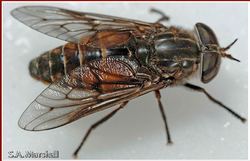Contact Us
Call a Helpline:
Arroyo Grande (805) 473-7190
San Luis Obispo (805) 781-5939
Templeton (805) 434-4105
Send us an email: anrmgslo@ucanr.edu
Follow us on social media:
Tabanidae

If any of you gardeners decided to take a break from gardening and went to the mountains to go camping, then you have undoubtedly been bothered by deer flies. Those are the medium sized flies that will fly around your head going buzz, buzz, buzz, and then land somewhere on your back or the back of your arm and ambush you with a painful bite.
On my trip to French Guiana, one may think that the biggest problem would be mosquitoes. But, that was not the case in French Guiana. Mosquitoes were an occasional problem but the biggest nuisance was horse flies. These big, aggressive flies would hound us continuously throughout the daylight hours. They could bite right through our levis, and it was painful. With deer flies and horse flies, there is nothing subtle about their bite. They have stiletto shaped mouthparts with which they stab you, and then lap the blood as you bleed. Mosquito bites can be painless, and blood is actually sucked from under the skin around our capillaries. Around California, one of the diseases that deer and horse flies are known to vector is Tularemia, a bacterial disease picked up from rodents. It can be fatal. The “dirty needle” effect of the mouthparts is how the disease is passed to humans.

Tabanidae are unusual in that their larvae are predatory, and the adults are parasitic. Larvae inhabit swampy areas, drainage ditches, and wet meadows, where they live in watery mud and hunt any creature small enough to eat. They can bite, so care must be taken when handling them. The adult flies have large, often colorful eyes (note the pictures) which come in handy when looking for blood hosts. Deer flies are generally a bit larger and more robust than a house fly. Horse flies are large, robust flies, up to 3/4 of an inch long. Our local horse fly, the fly that has a black abdomen and grey thorax in the picture provided, is a large fly. They seldom bite humans but when they do you can be sure the bite is of short duration as you would be looking to smack it as soon as possible.
Drainage of local swamp lands has cut down on their populations, so they are probably not as much of a nuisance as they used to be. In most cases, repellent will keep the adults at bay, but you can tell when it is starting to wear off.




